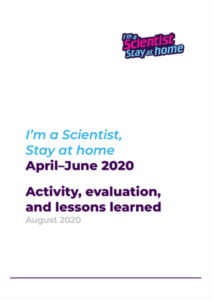I’m a Scientist, Get me out of here is an online, student-led STEM enrichment activity. Since 2008, we have connected school students with scientists through energetic instant messaging-style chats.
With the fast onset of the COVID-19 pandemic, I’m a Scientist, Stay at home was planned in a short four week period of turmoil and uncertainty from late-March to mid-April 2020. The pandemic completely changed the way we run our activity.
This report is a summary of the activity in, lessons learnt, and an evaluation of the impact of this event.
Our capacity modelling was based on 5% of UK schools requesting space in the activity. This seemed reasonable based on promotional support and our unique position of being able to provide online STEM enrichment at scale. This would involve up to 150,000 students connecting with 1,800 scientists.
Recruitment
Interest levels were excellent. By the end of the first day of school activity we had over 1,000 scientists and engineers signed up. By the end of the summer term we had 2,450 applied to take part.
Interest from secondary school teachers was strong too. Teachers from 12% of UK secondary schools signed up to take part with their students.
However, interest from primary schools was weak. Only 1% of primary schools signed up. As the demands placed on primary schools became clear — children of key workers; return of EYFS, Y1 and Y6 after half term; and uncertainty over it all — it wasn’t altogether surprising.
Converting interest into activity also proved to be a challenge. Out of the 1,068 teachers signed up, only 262 had students participate. 190 schools in total.
The intention and interest from secondary schools was significantly higher than expected, but conflicting pressures prevented that intention from converting into action.
We created capacity for 100,000 students but in the end only 6,945 students created accounts.
Teachers faced challenges:
- Increased workload to provide centre assessed grades
- adapting to remote teaching
- providing childcare for their own children
- student compliance with teaching instructions
- Equity issues resulting from access to IT for students at home
Some schools ran video lessons, some maintained a timetable, some set occasional work. STEM enrichment mostly became a voluntary activity rather than a lesson.
For those who did participate the experience was excellent.
The student to scientist ratio in chats at around 1:1 was better than normal (6:1 in November 2019). This led to more in-depth conversations, to greater satisfaction from students who got their questions answered and from scientists who felt less pressured and committed.
“
For those who did participate the experience was excellent.”
Interviews with teachers and analysis of live chat transcripts allowed us to build on previous research. It provides confidence that the activity continues to support students’ science capital. They continue to build rapport with scientists, to understand the variety in STEM and to see science as something for them.
We also heard from teachers that it provided a rare chance for them to connect with their classes.
There were considerable benefits for the scientists too. For one self-isolating scientist it felt like a lifeline. For others it helped motivate them through a difficult, isolated time. For most it was the main or only outreach activity they were able to do during the summer term.
Researchers have been encouraged to make public engagement a key part of their work. We are glad we were able to help them maintain their commitment.
Legacy
The I’m a Scientist, Stay at home programme isn’t finished. There is a legacy to funding provided and the work done so far with it.
Uncertainty remains in the UK education sector. Students were generally in school for the autumn term but with 35% absent due to self-isolation at points in November. So far in 2021 schools have asked students to learn from home.
Scientists and engineers will not be able to visit schools for the foreseeable future. Visits to museums and workplaces are not likely.
In September 2020 we launched I’m a Scientist: On Demand. It is available for teachers to run STEM enrichment at a time that suits them. The investment we made in I’m a Scientist, Stay at home made this service to teachers possible.
We continue to build on the development we did since April. The student registration process has been improved. Our back-end system changes allow us to operate with large numbers of teachers and scientists efficiently. Dynamic lists of scientists so students can focus on the people they are engaging with are live. The chat calendar has been improved again, to allow teachers to make requests for certain types of STEM professionals.
We are currently running shorter 4 week zones to make the commitment more manageable for scientists. We are bringing back the cash prize to increase the involvement and agency for the students.
In the autumn of 2020 we ran a zone for Science Centres to maintain contact with their schools. Resourcing issues for science centres made this difficult, but the Centre for Life in Newcastle participated and managed to engage with 57 teachers and over 450 students.
Summary
In summary, I’m a Scientist, Stay at home, was planned in a period of great uncertainty. The levels of student participation were lower than expected, but those that did had an excellent experience. The funding provided continues to provide a legacy. Development work has improved the activity and made it more efficient to run. It has allowed a continuation of excellent online STEM enrichment throughout 2020 and the Spring Term of 2021.
Funders
I’m a Scientist, Stay at home received core funding from UK Research and Innovation and Wellcome Education. Further Zone funding from bp PLC, the British Psychological Society, Johnson Matthey PLC, the Medical Research Council, the Ogden Trust, the Royal Society of Chemistry, Tomorrow’s Engineers and the Wellcome Genome Campus. Additional funding from Tideway. I’m a Scientist, Stay at home received additional support from the British Science Association and STEM Learning.


